Few places in Grand Cayman offer the expansive, open views of the Caribbean Sea like those seen from the top floor of The WaterColours condominiums.
To start, most places lack this elevation. On an island with an average altitude of six feet, it’s a luxury to take in the turquoise waters and white sand beaches from a 10th-story perspective.
Until recently, only this complex, a 2014 creation of luxury developer Fraser Wellon, and Kimpton Seafire Resort by the Dart group, the islands’ largest private landowner, had achieved such heights. That’s soon to change, but for now, this particular sea view, from the top-floor penthouse of the late Jamaican tourism mogul Ernest “Ernie” Smatt, remains one of Grand Cayman’s most elite.
The complex is just one of dozens of luxury condominiums that have filled in Grand Cayman’s vulnerable coastline over the past decade. During the COVID-19 crisis, construction of such projects has accelerated, exposing the local population to serious climate change threats in exchange for properties most Caymanians cannot aspire to own in a lifetime.
For a condominium like Smatt’s, listed at US$8.5 million, to even reach the open market is unusual, notes RE/MAX broker Kim Lund. Landing one can require insider knowledge, he explains, as owners of these exclusive properties often trade among themselves.
Cayman’s open and mostly tax-free real estate market means that any one from anywhere can buy, trade and profit off of Cayman Islands properties — effectively opening the market in this British territory of around 70,000 residents to the world’s highest bidder.
The setup attracted an estimated US$9.9 billion in Cayman Islands property sales, representing nearly 17,000 transactions, from January 2011 to December 2021, according to a Center for Investigative Journalism (CPI, in Spanish) and Cayman Current analysis of Lands and Survey Department data. Nearly half of those sales were concentrated in the Seven Mile Beach corridor and the high-end Rum Point neighborhood.
Government revenue data indicates a sharp increase in wealthy transplants and real estate investors to the islands during the pandemic. In 2021, Cayman saw a spike in residency revenue from “persons of independent means” – in other words, individuals with enough money to buy their way into the Cayman Islands. Residency-related fees from these applicants reached nearly US$9 million (CI$7.5 million) in 2021 — a 76% increase over the proceeding three-year average.
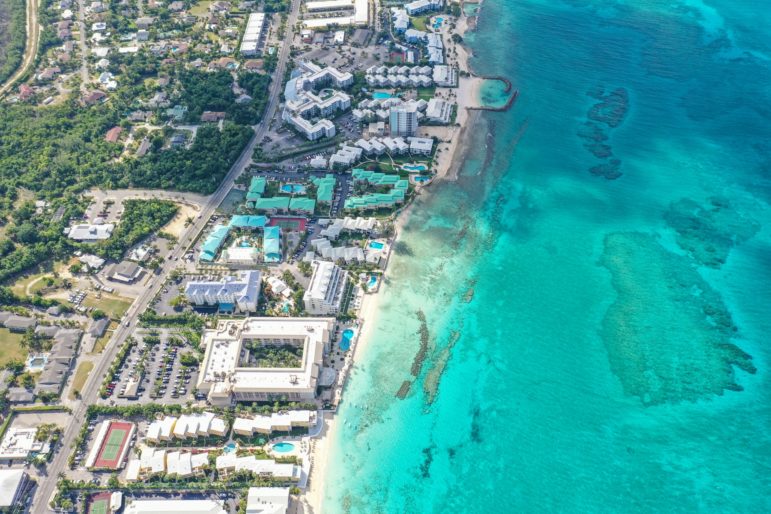
Photo by Jon Schutte| Centro de Periodismo Investigativo
To secure such wealth-based residency in Grand Cayman, applicants must invest at least US$1.2 million in the islands, half of which must be in real estate; maintain a deposit of at least US$480,000 (CI$400,000) in assets with the Cayman Islands Monetary Authority; and earn an outside, annual income of at least US$144,000 (CI$120,000). Meeting those criteria qualifies applicants for a 25-year residency certificate with the ability to renew.
The view from Smatt’s corner unit is ideal to comprehend the progression of Cayman’s luxury property market — already a far cry from when he sold this same site, the former Beach Club Colony, to The WaterColours for US$41 million (CI$33.6 M) just a decade ago.
Smatt’s main balcony now overlooks half a dozen new, 10-story hotel and condominium projects along Seven Mile Beach, from Dart’s Indigo Hotel site to the north to the HHG hotel site to the south. Construction continues on Cayman’s most prized beach despite repeated environmental advice by the Department of Environment and the National Conservation Council to cease building near the increasingly crowded and erosion-prone coastline.
In a few short years, Grand Cayman is set to quadruple its count of 10-story buildings — a point of tension on an island where less than a decade ago structures over five stories were prohibited. In 2014 the territory amended its legislation to accept 10-story buildings. The WaterColours and the Kimpton towers came shortly after.
With a development policy now 25 years old, a government budget still reliant on development revenue and an industry-friendly planning board at the helm, Cayman has seen a revival in community and environmental activism, as islanders increasingly question the territory’s uneven and ill-defined course of development.
“When you look at Seven Mile Beach, our country is not our country anymore,” said Eden Hurlston, a local musician and activist with Amplify Cayman.
“We’re talking about opening tourism but what am I going to bring them back to? … We’re becoming unrecognizable even to ourselves and that creates a kind of displacement psychologically speaking,” he added.
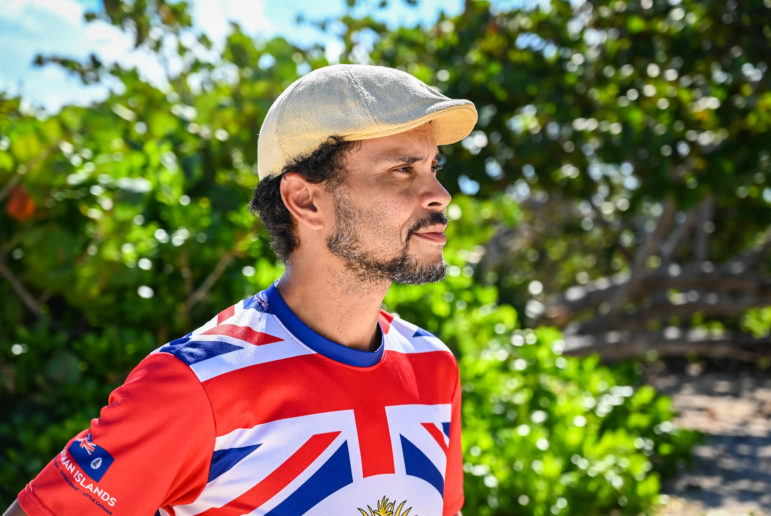
Photo by Kayla Young | Centro de Periodismo Investigativo
Like many Caymanians, Hurlston abruptly lost his work in tourism, performing music at local resorts and community events, when the islands’ borders closed to visitors in March 2020 due to the COVID-19 pandemic.
Nearly two years into the crisis, Hurlston notes that while the Cayman Islands still prohibits music and dancing on Sundays, construction work continues in his West Bay neighborhood seven days a week.
“We’re having a type of imperialism that is going on, that is destroying the property market,” Hurlston said. “This cycle is fine if you’re a luxury developer, but if you’re everybody else, it’s death.”
The rapid pace of development has left Hurlston and many other Caymanians with a sense that they have lost the home they once knew.
Tour operator and fellow activist Shirley Roulstone describes a community that risks losing its democracy and its sense of self.
“The fact that so much has slipped out of our hands over the past years, is something that new newcomers will never understand because they can’t picture it. We can’t undo it,” Roulstone said. “A lot of what you see now is just not Cayman.”
As Caymanians struggle to recover from the COVID-19-induced collapse of their tourism industry, long considered the twin economic pillar to financial services, the real estate and construction sectors have enjoyed a boom period — and the effects are stratifying Caymanian society along political, economic and even environmental lines.
Whereas 2020 saw a record number of Caymanians turn to public housing and food assistance — about 5,000 people across 2,500 families — it also saw average home sales’ values climb 28% to just over US$1.2M, according to Property Cayman analysis.
In 2021, real estate sales had surpassed a record US$1.5 billion for the year, with a third of that in the Seven Mile Beach area, CPI and Cayman Current found. That figure represents a 40% increase from 2020 and a 79% increase compared to 2011.
The contrast between soaring property sales and community discontent has become a point of national conversation, recognized by Premier Wayne Panton. In brief, colloquial terms, “Cayman gone,” Panton told Parliament in late November, parroting a common local lament.
“The warning signs have been there and we chose to balm it over with temporary relief. Too many of our people are facing a growing crisis. Too many cannot cope, let alone adapt. Too many are getting left behind,” Panton said.
“Housing and land prices have soared out of reach for most Caymanians, including our well-educated, young professionals … A growing number of Caymanians feel anxious and marginalized and at times unwelcome in their own homeland,” Panton added.
When the islands held their national elections in April, the territory faced an uneasy decision — continue with a government that had kept the islands largely COVID-free but struggling to survive under 8.3% Caymanian unemployment, or gamble on a loosely affiliated group of independents, now led by Panton.
Caymanian voters would ultimately trade in the incumbent The Progressives party for the comparatively green independent coalition, PACT — an acronym for People-driven, Accountable, Competent and Transparent.
UK-appointed Governor Martyn Roper says the 2021 election sent a message about local environmental priorities.
“The last election did show that a lot of people in our community do want more balance between economic development and the environment,” Roper said.
“There’s incredible interest and drive from our youth in Cayman for our elected politicians to do more on this agenda.”
While Roper agreed Cayman is not doing enough to address climate threats, he isn’t the policymaker here. The UK serves an auxiliary role to the territory, by connecting Cayman to financing opportunities and expertise, Roper explained. Implementing environmental and development policy is a matter for locally elected officials.
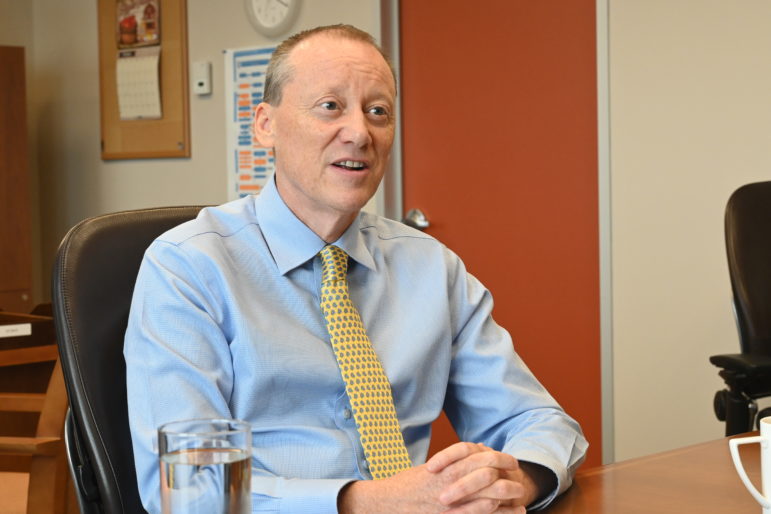
Photo by Kayla Young | Centro de Periodismo Investigativo
Less than a year into the PACT administration, the verdict is still out on whether the coalition will be able to follow through on its stated environmental goals and achieve what previous governments have not — comprehensive development and environmental policy, tailored for the climate change era.
Premier Panton declined requests made over three months to discuss climate and development policy for this investigation. The Department of Environment also declined interview requests made through various channels over several months.
While environment was an important mobilizing issue among PACT voters, development remains central to the islands’ COVID-era economic strategy. Alongside financial services, the construction sector has buoyed the Caymanian economy since the early days of the pandemic.
Construction crews were the first to return to in-person work during Cayman’s three-month lockdown period from March to July 2020. By fall 2020, construction had risen from the second to the first largest employer in the islands, representing 12.2% of the workforce, compared to the same period in 2019.
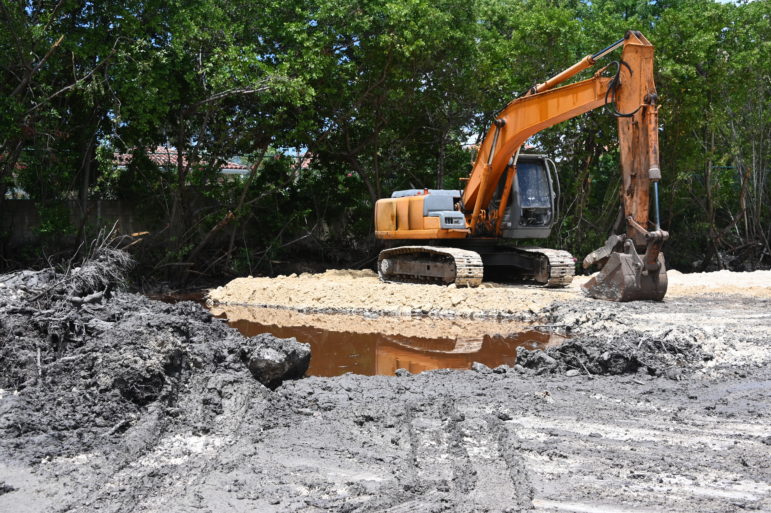
Photo by Kayla Young | Centro de Periodismo Investigativo
After the PACT coalition assumed power in April 2021, the new government presented an economic plan that relied largely on infrastructure projects, in particular the NCB Hilton, the Hyatt and Indigo hotels along the Seven Mile Beach corridor and the Mandarin Oriental hotel on one of the only sandy beaches in the Savannah community, Beach Bay. Infrastructure Fund contributions, raised through fees charged by square foot of construction, are forecast to grow more than 10 times in 2022 compared to 2019, the last pre-pandemic budget year. Stamp duty charged on property transfers represented the government’s third-largest coercive revenue source in 2021, providing US$120.6 million (CI$98.9M) — a 67% increase compared to 2019.
Panton’s administration has also made broad, symbolic gestures around improving Cayman’s environmental record — one that has seen Seven Mile Beach eroded away to a 3.5 to 4-mile beach; mangrove habitat diminished to less than a quarter of its historic acreage on Grand Cayman’s western side, and worsening flood impacts in low-lying, often historically Caymanian neighborhoods like George Town’s Windsor Park and Bodden Town’s Cumber Avenue.
In one of Panton’s first acts as premier, he established the Ministry of Sustainability and Climate Resilience, which he also leads, an immediate symbol of divergence from former Premier Alden McLaughlin, who left Cayman’s only climate change policy unimplemented for the course of his nearly eight-year leadership.
That policy is now up for review, after Panton announced during COP26 he will conduct a new climate change risk assessment for the islands.
Meanwhile, Investment Minister Andre Ebanks launched the Commonwealth Climate Growth Fund (Cayman) LP with an initial commitment from the government of US$25 million and the intention to fund climate mitigation and adaptation projects.
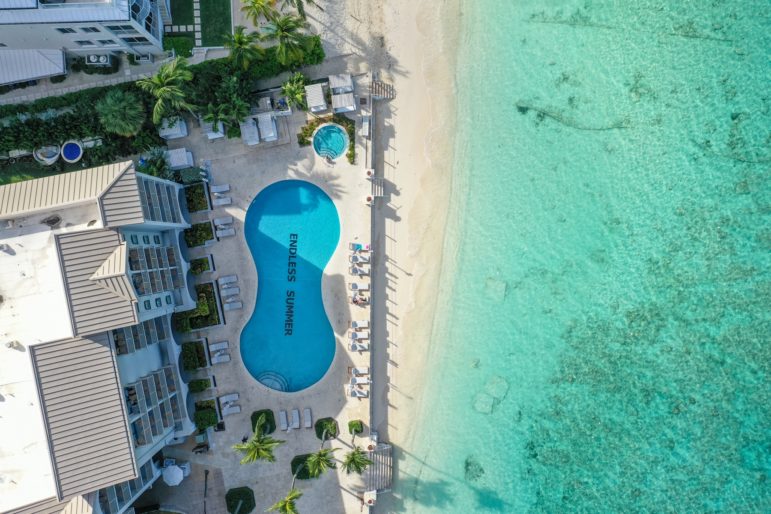
Photo by Jon Schutte | Centro de Periodismo Investigativo
As for Seven Mile Beach, the government has proposed spending US$25.6 million (CI$21 million) over two years on a “beach renourishment” project that would aim to restore lost sand at the Grand Cayman Marriott Beach Resort, where there is little beach left and the sea crashes directly into the resort’s western edges. The plan would add sand deposits to the coastline but no announcements have been made regarding the seawalls that have intensified erosion along southern Seven Mile Beach.
Legislative fragmentation
To achieve truly climate-resilient development, Cayman still has a long way to go legislatively.
Resistance to development planning is nothing new in the Cayman Islands, explains Lisa Ann Hurlston-McKenzie of the National Conservation Council, the body tasked with providing feedback on environmentally significant government decisions — like approving new beach resorts.
That resistance, she said, is why Caymanians protested the proposed and ultimately failed 1975 development plan, which set out to establish large areas of protected mangroves and forest habitat.
“We’ve just been in this modus operandi in this country for 40 years that developers are king and beyond cash being king, land is king,” Hurlston-McKenzie said.
The attitude reflects in Planning Department decisions and the frequent disregard for environmental advice, she says, like respecting minimum coastal setbacks. The FIN condominiums, built directly on the iron shore in South Sound, is one clear example of a new luxury development with no coastal setback.
Cayman’s legislative separation of planning and environmental policy has frequently put environmental feedback at odds with the development sector. Moving forward, Hurlston-McKenzie says Cayman must integrate its planning framework with its climate change objectives.

Photo by Jon Schutte | Centro de Periodismo Investigativo
“We can give feedback but when it comes down to the actual implementation of those recommendations, that’s when it’s out of our control, as we’ve seen with the Central Planning Authority (CPA),” she said. “It’s just gotten more ridiculous in that they’re now being made to believe by certain interests that the conservation law is erroneous in being able to direct the CPA, which is not true.”
For 20 years, subsequent Caymanian governments have failed, as required by law, to update its 1997 Development Plan — a 21-page document that outlines broad, overarching goals to guide the islands’ growth.
Rather than an action plan or roadmap, the policy offers ambitions — but it remains the islands’ only guiding document to analyze development-related decisions.
The ongoing absence of a modern development framework has effectively punted Cayman Islands government powers to the business sector, the Auditor General has warned.
“The failure of governments to maintain the currency of development plans may have led to the impression that this important government responsibility has been allowed to pass to the private sector,” the Office of the Auditor General wrote in 2015.
The Dart organization was one major developer implicated in the report, which found its secretive National Roads Authority Agreement with the government had disregarded the development plan and violated the law. That same year, MLA Ezzard Miller told local media that Dart had already acquired a third of Grand Cayman and that the company’s footprint was growing. [CPI/Cayman Current were able to confirm, through review of Lands and Survey records, that Dart entities held 9% of Grand Cayman.]
The result has meant not only diminished control by the legislature, but also “unreasonable environmental degradation and water management problems,” a proliferation in “informal housing” and improper disposal of sewage.
In the absence of larger infrastructure solutions, new building permit approvals have pushed forward based on the discretion of planning authorities. Through a CPI and Cayman Current request, the Department of Planning reported US$4.2 billion in approved permits from January 2010 to October 2021 — although many permits listed by Planning lacked a dollar value or varied from previously reported numbers, making a true value determination difficult. Still, value reported doubled from 2018 to 2019 and continued increasing in 2020 and 2021.
Of reported permit values, the pandemic era has accounted for nearly a third.
From January 2020 to October 2021, the islands saw a record US$1.3 billion in approved building permits.
As for real estate sales and property records, the Lands and Survey Department keeps that data behind a hefty paywall. The department maintains that these records do not fall under the Freedom of Information Law because such information has been monetized.
Lands and Survey offered CPI and Cayman Current access to its mapping database for a US$13,400 annual fee.
Luxury ‘above and beyond’ anything imagined
Back at The WaterColours on Seven Mile Beach, Lund says developers can’t build fast enough to satisfy international demand for Cayman’s high-end property. While he says the “sight-unseen crowd” — buyers willing to purchase without stepping foot in Cayman — has now been mostly tapped out, he expects another wave of buying once travel restrictions ease and visitors return sometime in 2022.
“There is new construction and new development coming along, but not at the pace that we’re selling at right now,” Lund said. “So, there’ll probably be a lag in terms of sales in 2022, only because we don’t have the inventory available to sell.”
Up the beach from The WaterColours, for example, sits the work site for Cayman’s next pinnacle in luxury living and the latest Wellon project, The WaterMark. The construction site spans from the beach and across the roadway, hinting at the enormity of the future structure. The US$216.5 million (CI$177.5 million) complex promises 54 luxury condominiums, 12 swimming pools, on-site fine dining, spa and fitness facilities, private elevators, quarters to room staff and private pilots, boardroom facilities and chauffeur services.
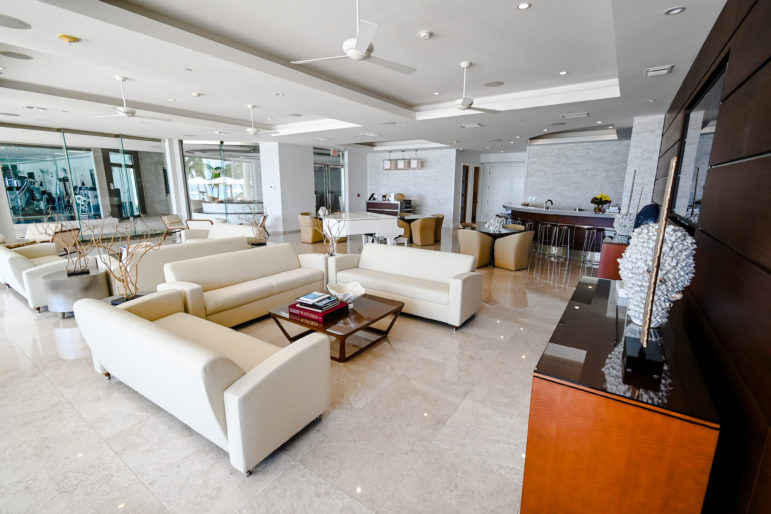
Photo by Kayla Young | Centro de Periodismo Investigativo
“The WaterMark is just above and beyond anything ever dreamed of, ever contemplated of being built, definitely in the Cayman Islands and possibly throughout the whole Caribbean for that matter,” Lund says.
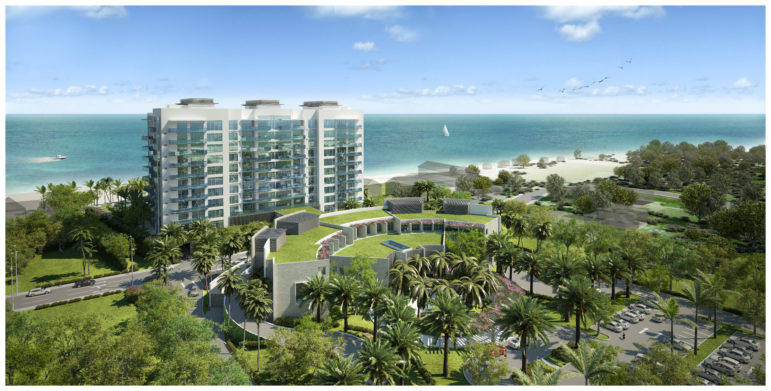
Photo Rendition: Submitted
The complex is still two years from completion, but units are in such high demand, Lund had already managed 14 resales as of late 2021. Many WaterColours residents, ready for the next best thing, are trading up, Lund notes.
UniRegistry millionaire Frank Schilling is among them, posting a photo of the WaterMark construction site shot from his personal helicopter to his Instagram account in May 2021 with the message, “I can see my house from here!”. In recent years, Schilling has become a major Cayman Islands real estate investor, but still remains far from rivaling Kenneth Dart and the Dart organization.
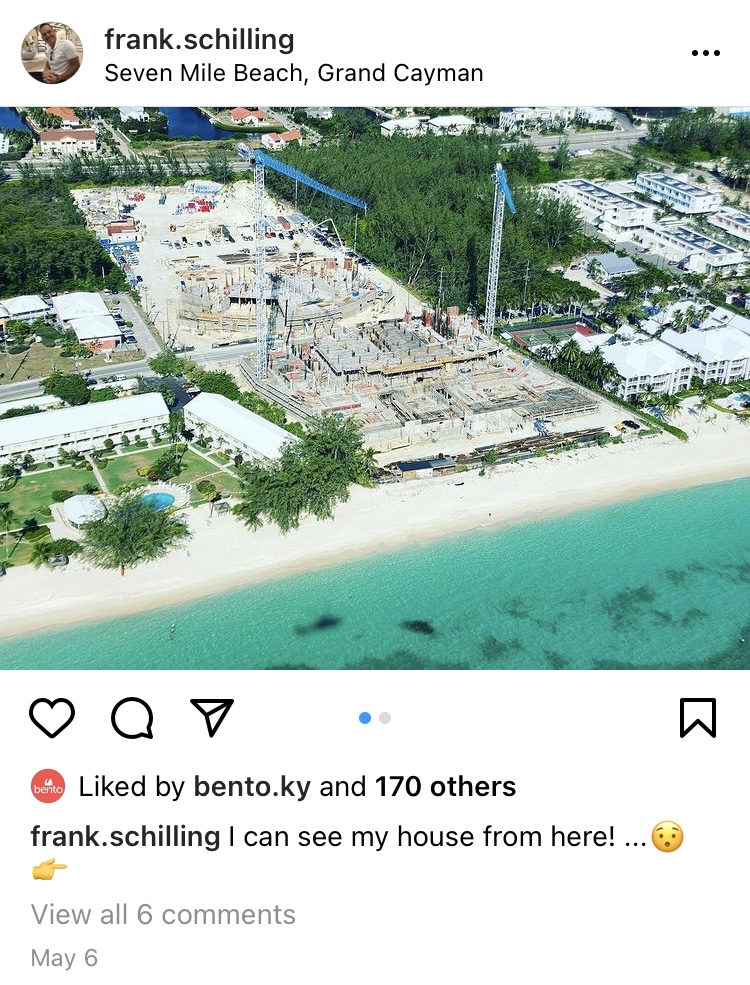
Instagram screenshot.
While The WaterMark sales are not yet reflected in Lands and Survey records, real estate listings show units advertised for up to US$13M.
Ghost beach scene
Despite the Department of Environment urging in August 2018 to minimize the WaterMark site’s impact on Seven Mile Beach, coastal works here have continued. As of January 2022, beach erosion was already visible along with the construction site.

two years from completion.
Photo by Kayla Young | Centro de Periodismo Investigativo
“The removal of the beach ridge is a major concern. Seven Mile Beach is an extremely active beach system and the seaside parcel consists of massive sand reserves,” the Department of Environment wrote in its August 2018 submission to the Central Planning Authority, the body charged with evaluating and approving Grand Cayman’s building proposals.
“The amount of sand that will result from the excavation for the pools, foundations and underground parking will likely be too great a quantity to be placed back on-site and into the beach system. Once excavated and removed from the beach system, these sand reserves can never be recovered, making the beach system increasingly more vulnerable to erosion,” the department continued.
A month later, in September 2018, the Department of Environment issued The WaterMark a cease-and-desist order. As of August 2021, it was one of just 11 such orders issued by the department since the National Conservation Law conferred the power in 2013. The department identified four active turtle nesting sites along the WaterMark beach, and ordered an immediate end to all clearing works utilizing heavy equipment. The department did not disclose any fines or consequences following the notice, other than the temporary stoppage of works.
While Seven Mile Beach is an active coastline, inclined to natural changes over time, inappropriate infrastructure development — most visibly around Grand Cayman Marriott to the south and Boggy Sand Road to the north — has exacerbated the shore’s erosion issues, explained Cathy Childs, environmental programs manager with the National Trust for the Cayman Islands.
“Many factors are involved in the erosion of Seven Mile Beach, but the underlying problem is that some properties have been built too close to the water on the active beach. Seawalls make the problem worse because they can cause beach erosion due to the scouring action of the waves when they rebound off a hard structure,” Childs wrote. “It is imperative that new properties observe a large setback from the active beach. It will become necessary to consider managed retreat of some areas in which hard structures on the active beach will need to be removed and relocated further back.”
A point that doesn’t sit well with Shirley Roulstone, a tourism operator turned community activist, is that for all the demand and pressure on Cayman’s natural spaces, many of the island’s new coastal complexes sit vacant.
Only about a third of the WaterColours’ residents, for example, actually live on the island, Lund says. Owners there have registered home addresses in Italy, Canada, the United States, Switzerland, the United Kingdom, Poland, France, Australia and Jersey — although the majority have opted for a Cayman Islands PO Box, according to Lands and Survey data. Many properties are owned by holding companies, making the ownership difficult to trace. Known owners include Schilling and South African billionaire Clive Calder. Chilean businessman Leonardo Farkas, who has also invested in other Wellon-developed properties, recently announced that the Cayman Islands would become his primary domicile.
“We’re losing our coastlines, our beach for concrete structures for people to hold as an investment,” Roulstone said. “We don’t get to use those beaches or those coastlines anymore because our property has been replaced by structures for people that don’t even live here.”
Some real estate businesses, like Oasis Land Development Limited, have even tailored their services to buyers who have likely never visited the Cayman Islands. Notes on the company’s land sales indicate US$8.6 million (CI$7,072,458) worth of its Cayman property deals had been negotiated in Chinese Yuan or Renminbi between June 2015 and July 2021, primarily in the low-population and land-rich districts of Bodden Town, East End, North Side and Cayman Brac.
One of the largest known Cayman land transfers to a China-affiliated developer was, in April 2015, to Datang Investment for US$8.1 million (CI$6.6 million) from 7 Mile Holdings for 43 acres in the South Sound mangrove basin. The site, largely mangrove habitat, was deforested and then left vacant, to fill in with invasive casuarina trees that spread quickly.
Gentrification in progress
Not so long ago, Caymanians were the ones considered “land rich,” explained academic and author Roy Bodden, but few saw the value in coastal plots where they couldn’t grow crops like corn or cassava for sustenance.
As early as the 1950s, Bodden said Commissioner Andrew Morris Gerrard warned Caymanians about the consequences of selling off their “birthright” — the land — for “a mess of pottage.”
Cash in pocket, however, provided instant economic gain. That era brought one of Cayman’s first great land transfers and ushered in the islands’ first beachside resorts, like the former Beach Club Colony.
“They thought, great. This is a windfall for us. This is the time for us to get wealthy. Because every Caymanian had land,” Bodden said. “Now they’re cashing in to the exclusion of the Caymanians, particularly the young, middle-income, upwardly mobile Caymanians who cannot afford property prices.”
What Cayman is experiencing now, Bodden said, is akin to gentrification — the effects of a “frontier society” where lax regulations and a desire to make a quick profit have separated generational communities from the land.
“There are two Caymans,” Bodden said. “There’s one Cayman for the wealthy. The other Cayman is for the poor… People are living in shacks and shanties off the beaten track. Because nobody sees them, we think they don’t exist, but they very much exist.”

Photo by Kayla Young | Centro de Periodismo Investigativo
In those back roads, countless families have crowded into structures that lack proper plumbing, kitchen and bathroom facilities or sufficient protection from flood waters during storms. One Bodden Town family reported paying US$975 a month to rent a unit lacking proper bathroom and kitchen facilities, where all three family members shared a twin mattress that barely fit into the space. Meanwhile, finding a two-bedroom rental for under US$2,400 a month is extremely rare in Grand Cayman.
Bodden fears a near future where the islands’ peaceful, safe reputation gives way to social upheaval — an island where the fences once constructed for exclusivity become necessary for security.
“You won’t be able to walk the streets as easily as you do now,” he warned.
Even in the pre-crisis era, the standard local wages didn’t stack up against the average home price. As of the most recent wage survey in 2017, half of Cayman Islands workers took home less than (CI$39,732) US$48,454 a year. That was before coronavirus brought salary cuts and business closures.
Minimum wage workers earn US$7.30 an hour, while tip-earning employees, such as waiters, and domestic workers, like nannies, earn a minimum of just over US$5. In contrast, the Cayman Islands ranks as one of the most expensive places to live on earth.
When properties with a lower price point do come on the market, CIREBA’s Jeanette Totten of ERA Cayman says they don’t last long due to low inventory.
“Because they were all bought up, the prices have really increased,” Totten said. “So, are they overvalued? Yeah, maybe.”
She fears the bubble could soon burst for many middle-income Caymanians who were able to purchase homes during the crisis. As an economic relief measure early in the pandemic, the former Progressives government authorized private pension withdrawals of up to US$12,000 (CI$10,000) plus 25% of the remaining balance. Those funds, intended to provide an unemployment cushion, also gave a boost to would-be homebuyers.
“Many of those people ran out and bought places because they had a huge down payment that they were never able to save for before. So that really made the local market very strong,” Totten said.
“[But] if you work in the tourism industry, if you’re a maid or you’re a dive master and you were able to buy a house before all of this craziness happened, you don’t have a job. And the little bit you’re getting from the government is not going to make your mortgage payment and buy food and pay all the other bills.”
As of December 2021, the government reported around 3,000 unemployed Caymanian tourism workers, 14% of the Caymanian workforce, continued to rely on unemployment stipends.
Between December 2019 and February 2021, requests by Caymanians to the National Housing Development Trust to purchase affordable homes doubled from 196 applicants to around 400, according to reporting by the Cayman Compass. Meanwhile, the government broke ground on seven “affordable homes” in East End, far from the island’s population and jobs center in George Town.
Superficial changes
In South Sound mangrove basin — where nearly 80% of the 620-acre wetland habitat has been slated for development — Planning Minister Johany Ebanks popped in for an impromptu meeting in October 2021 with environmental activists representing Amplify Cayman, Sustainable Cayman and the Mangrove Rangers.
While no legislative commitments had been made as yet, Ebanks wanted the group to know that he’s willing to engage.
“I’m wanting to try to refocus the mindset of the way Planning actually looks at things,” he said. “And I think the only way we can actually do that is by legislation.”
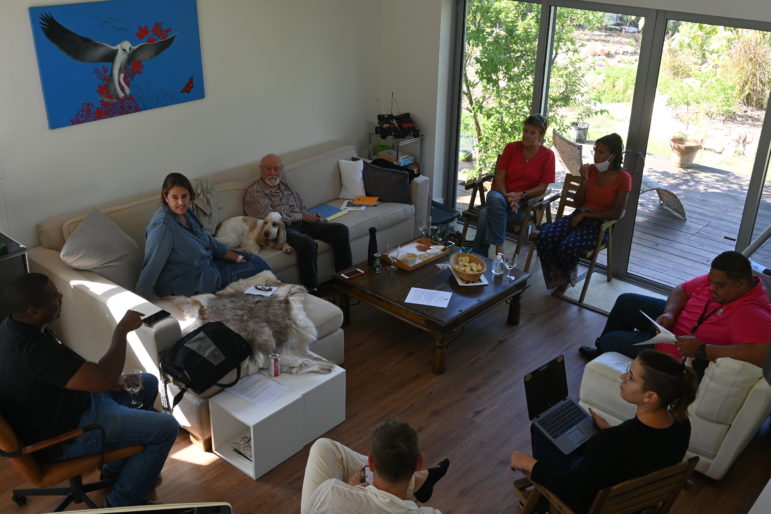
Photo by Kayla Young | Centro de Periodismo Investigativo
To start, he says the government is looking to increase beach setbacks for construction projects and at taking back long-contested spaces like West Bay’s Barker’s peninsula, largely owned by Dart. He also agrees that beachside development has gone too far.
“I think we should have never built on our beaches. Everyone should have been building on the opposite side of the road, but it is what it is now and something that we’ve just got to keep moving forward with,” he said.
If environmental advocates can compromise on building higher, Ebanks says, he may be able to negotiate with developers.
“Most of the developers that actually came back to me are okay with giving us a lot more beach. They’re just wondering if the country and everybody else is going to be okay with maybe building a little bit higher,” Ebanks said.
Here in South Sound, he has agreed to reconsider the location of a government affordable housing project, due to the environmental impact on the wetlands.
“I realize that you guys don’t have too much areas left in South Sound. Everything’s been taken over,” Ebanks said. “I didn’t want to develop that because I felt that Randyke is in a very sticky position right now.” Randyke is a neighborhood that faced raw sewage flooding into homes in 2007 and 2011 — a consequence of the island’s inadequate wastewater system and reliance on piecemeal flood planning.
If the housing project proceeded, Ebanks warned it could “basically destroy Randyke again.”
Breaking up the ‘old boys’ club’
One of the stickiest issues for Ebanks and his department to tackle will be reforming a long-entrenched system within the planning regime that has allowed infrastructure issues to fester for decades.
Within three months of taking office, Minister Ebanks made a significant political gesture, replacing the entire 13-member Central Planning Authority overnight.
The announcement forced the CPA to cancel its final planned meeting in 2021 under longtime chair A.L. Thompson, known for the island hardware store chain that bears his name and his influence in the development sector.
“I want to just take down all the monopolies that we’ve had making the decisions,” Ebanks said.
But old habits die hard and even with new members, the CPA faces the same old problems. Members still come directly from the construction sector and many months into their tenure, new board members have failed to publish notice of interest forms — making it impossible for public observers to verify if members have properly declared conflicts before reviewing applications.
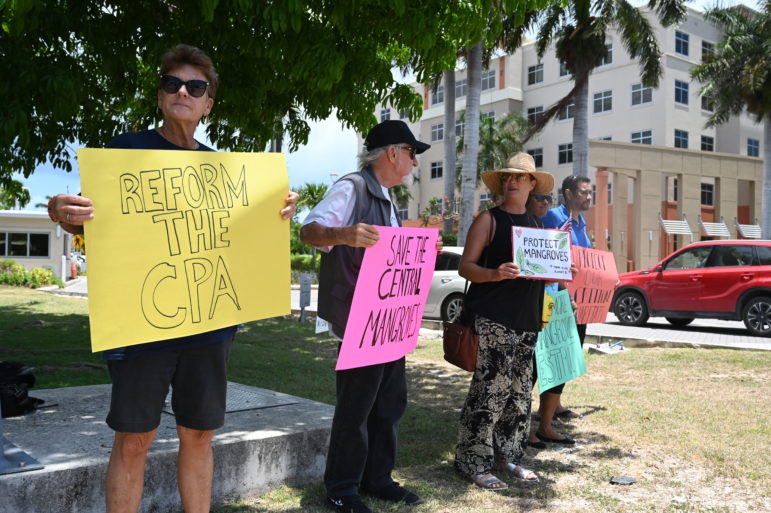
Photo submitted
The concept of public meetings itself remains limited with regard to the CPA.
With no video or audio permitted, no broadcast of proceedings and final deliberations kept behind closed doors, the only official record of CPA proceedings are the minutes of long-time deputy director of Planning Ron Sanderson.
What Sanderson includes in the minutes is up to his discretion. On July 12, 2021, the first meeting of the new board, for example, he chose to exclude an outburst by Peter Campbell, a repeat CPA appointee and former vice president of the Cayman Islands Football Association (CIFA), one of the day’s applicants. Campbell was vice president of CIFA when its president Jeffrey Webb was convicted of fraud, racketeering and money laundering. Despite allegations that one of Campbell’s companies was used to move Webb’s money, he was not charged in the case.
Between assessing the day’s applications, Campbell stopped and directed comments at observers.
“I’d like to address these ladies,” Campbell said, pointing to a community observer and a CPI/Cayman Current journalist sitting in the back of the government conference room.
“It’s highly inappropriate to be running anything in the press. We are discussing matters off the record. If I see anything being quoted on me personally, I’m going to have a big issue with it.”
CPA Executive Secretary Haroon Pandohie later apologized for the incident and said Campbell misspoke.
Such an outburst may reflect the old CPA — whose meetings were held behind closed doors until 2015 — but it clashes directly with a stated commitment by Premier Panton to establish a government based on transparency.
“In the same way that the [Department of Environment’s] National Conservation Council meetings are held in public, we want to see CPA meetings also be made public unless there are very good reasons not to do so, having to do with data protection or commercially sensitive material,” Premier Panton said in a July 8, 2021 public address. “We believe that demystifying the work of the CPA will be to everyone’s benefit.”
The challenge for Cayman’s lawmakers moving forward will be in finding political courage to take on the status quo, says lawyer Sammy Jackson, a drafter of Cayman’s 1997 development plan.
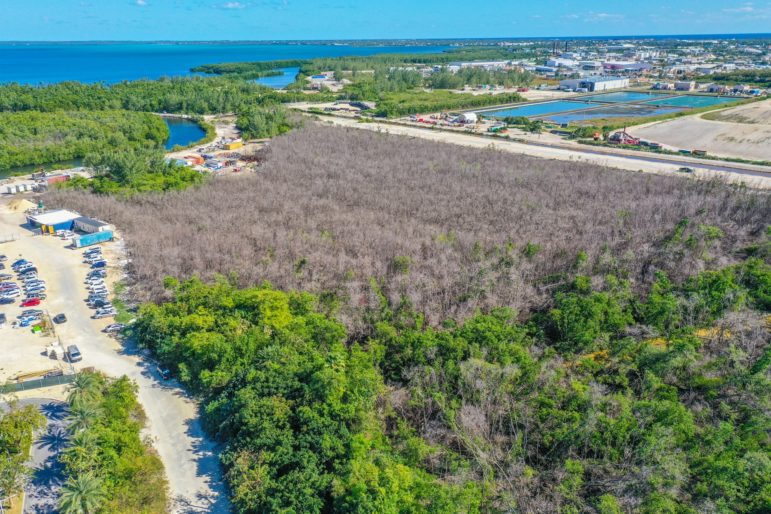
Photo by Jon Schutte via Cayman Islands Mangrove Rangers
While the task will not be easy, he is hopeful that what lawmakers accomplished then, under the leadership of Truman Bodden, can be done again.
“In 1997, we achieved what was previously unachievable because other administrations had tried it and failed, which was a significant amount of amendments to the existing [1977] plan,” Jackson said.
First, he says decision makers will need to remember the legislation they already have at hand — not just the existing development plan but, as he notes, the 2019 Public Authorities Act — a step towards good governance that seeks to address conflicts of interests and enforce relevant competencies on public boards.
“I am a conscientious Caymanian who would like to see the country march forward, not be stuck in some quagmire because of political cowardice,” he said.
“My concern is that we are going to be so desperate economically that we are going to make concessions legislatively and otherwise that we wouldn’t ordinarily make.”
To avoid such unnecessary sacrifice and to achieve sustainability — a nation that truly balances development and environment for the benefit of its people — Jackson says the legislature will need to step up.
“If Parliament isn’t going to amend the plan,” he says, “you can’t expect the Planning board to break the law, to give birth to something, some promise that some politician might’ve made on the campaign trail”.
As climate change alarms sound and sea levels rise, the stakes have become even higher than they were 25 years ago. Scientists with the United Nations Intergovernmental Panel on Climate Change now project with high confidence that the planet will reach 1.5 degrees C (34.7℉) of global warming above pre-industrial levels as early as the 2030s. For island nations, preventing this level of warming is a matter of survival. A one-meter sea-level rise would leave most of the Cayman Islands under water.
The investigations were possible in part with the support of Para la Naturaleza, Open Society Foundations and Fondation Connaissance et Liberté (FOKAL).
Next in Series
4 / 4
A Loss of ‘Caymankind’ and Island Ethos
26 January 2022
¡APOYA AL CENTRO DE PERIODISMO INVESTIGATIVO!
Necesitamos tu apoyo para seguir haciendo y ampliando nuestro trabajo.


